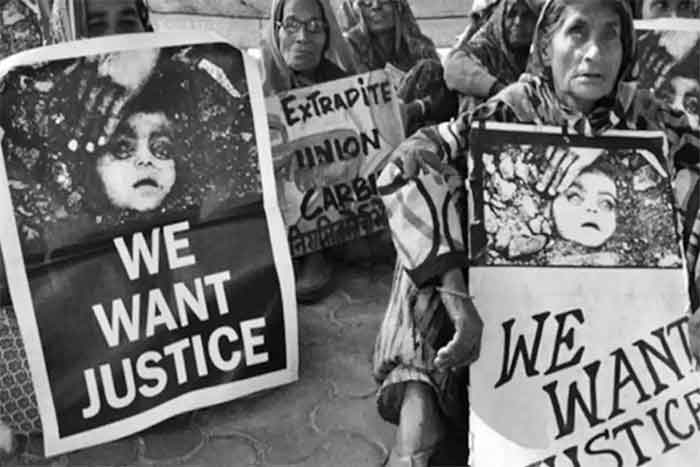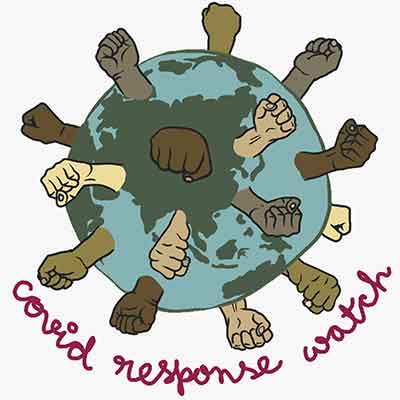
It has been 37 years since the deadly killer gas, methyl isocyanate, spread from the Union Carbide factory like a suffocating blanket of death across the old city of Bhopal, killing thousands of people on that night, and, then, slowly, over a long period of time.
The disaster shocked the country and the entire world. It was then called the worst industrial disaster in the history of the world – invoking memories of Nagasaki and Hiroshima. Later, of course, Chernobyl and Fukushima happened, among other big and small devastating disasters of similar nature and content. But, it seems, the world has refused to listen or learn any lessons. Certainly, not so in India.
Indeed, almost four decades later, a large number of the victims and the survivors in Bhopal, and their families, children, friends and relatives, are still struggling for not only justice, but with severe and debilitating health problems, and economic distress. Besides, in the pandemic, many of these survivors, with low immunity and multiple health issues and co-morbidity, were victims of the killer virus. Indeed, from methyl isocyanate to Covid, the tragic saga of the gas tragedy victims continues unabated.
Surprisingly, and it is a dark irony, that more people died of Covid in the first wave in old Bhopal, when compared to the second surge, which killed tens of thousands across many parts of India, including in Delhi, Gujarat and the Hindi heartland, especially with widespread absence of oxygen cylinders, hospital beds and medical care, amidst a collapsing or failed health infrastructure.
“Yes, it is true,” said Rachna Dhingra of the Bhopal Group for Information and Action, who have been consistently working with the people in Bhopal since the last four decades. “More people died in the first wave here when compared to the second wave, which was not so deadly in the old city areas.”
 According to the Bhopal Group, and the alliance of other gas victims’ organizations fighting a protracted struggle for their rights on the ground for four decades now, out of the gas victims who died due to COVID-19 in the first wave, 81 per cent suffered from serious co-morbidity as a result of gas exposure in 1984. Almost 75 per cent of the gas victims died within 5 days of hospitalization, and 84 per cent of the gas victims died within 24 hours of hospital admission.
According to the Bhopal Group, and the alliance of other gas victims’ organizations fighting a protracted struggle for their rights on the ground for four decades now, out of the gas victims who died due to COVID-19 in the first wave, 81 per cent suffered from serious co-morbidity as a result of gas exposure in 1984. Almost 75 per cent of the gas victims died within 5 days of hospitalization, and 84 per cent of the gas victims died within 24 hours of hospital admission.
“That is why we stressed on testing and monitoring of high risk gas victims. Despite the MP High Court order of April 21 which directed the Bhopal Memorial Hospital & Research Centre (BMHRC) to test gas victims visiting its hospital, this Indian Council for Medical Research (ICMR)-run hospital turned away several suspected gas victim patients who reported in the casualty ward. This refusal to admit, while referring to another government hospital, has killed at least five gas victims who later on tested positive, while crucial time was wasted in denying admission to these gas victims. While this criminal negligence continues in BMHRC, ICMR has turned a blind eye to the plight of some of the most vulnerable people,” said Rachna Dhingra in a press statement issued on June 22, 2020.
Based on official statistics and other information, analysis of 60 deaths between April 6 and June 11 by the Bhopal Group for Information and Action, stated the following:
- 74 per cent of deaths (45) due to COVID-19 were of Bhopal Gas Victims; 5 per cent of deaths due to COVID-19 were of children born to parents who were earlier exposed to the gas.
- In terms of breakdown of Covid deaths, an overwhelming majority of those under 60 were gas victims – almost 85 per cent.
- Almost 100 per cent of those who were ‘brought dead’ to the Hamidia Hospital in Bhopal were gas victims, while 87 per cent of gas victims numbering 27 people died in Hamidia Hospital.
- Almost 81 per cent of the gas victims who died due to Covid had co-morbidity, significantly because of the gas exposure, and loss of immunity. The rate of co-morbidity in the gas victims who died due to COVID-19 was five times more than the non-gas victims who died.
- Gas victims were suffering from multiple ailments and diseases of lungs, heart, kidney and brain.
In an urgent letter and appeal written on March 21, 2020, the Bhopal gas victims’ organizations had urged the authorities to take the situation as an emergency and find immediate and long-term solutions to the impending crisis. The letter sought identification, testing and medical care for the people affected by the Union Carbide disaster.
The letter was written to, among others the then Union Health Minister Dr. Harsh Vardhan, and Dr Balram Bhargav, Director General, Indian Council of Medical Research said: “As you may be aware, several reports to the Parliament, large number of studies published in international scientific journals and records of government-run hospitals in the last three-and-half decades have documented the long-term health damage caused to hundreds of thousands of Bhopalis as a result of their acute exposure to methyl isocyanate. At least a quarter of the 5,74,375 individuals officially acknowledged to have inhaled the poisonous gas are today battling chronic and disabling diseases…
The current data on COVID-19 indicates that people with any cardiovascular and pulmonary problems, diabetes, cancers and, most importantly, compromised immune systems, are 79 per cent more at risk of being infected by the Corona virus, becoming critically ill and dying… Data from eight community health units of the ICMR-run BMHRC 1998 to 2016 presented on their official website shows that 50.4 per cent of gas-affected patients suffer from cardiovascular problems, 59.6 per cent of them suffer from pulmonary problems and 15.6 per cent of them suffer from diabetes. Further, as per the records of the Office of the Welfare Commissioner, 10,550 (1.84 per cent of the gas exposed population) have been granted ex gratia compensation as cancer patients…”
Besides, it is an established fact that a significant majority of the survivors belong to economically weak sections. Most of them live in congested and unhygienic conditions with rooms as small as 100 sq ft, many lacking even running water. Most of them are manual labourers, working as sanitation workers, vegetable and cart vendors, drivers, security guards and casual/daily wage labourers. Not only the pandemic, the lockdown and the economic distress, had hit them very badly, pushing them to the edge of abject despair.
Meanwhile, the Bhopal gas-victims organisation have been organising a 37-day vigil and campaign, with 37 crucial questions, while protesting peacefully and sitting on a dharna during the month of November, 2021. Every day they ask one question. For instance, on the 12th day of their 37-day campaign, the survivors sought answers from the Ministry of Health and Family Welfare and the ICMR. They asked, “Why doesn’t the Bhopal Memorial Hospital & Research Centre have Gynaecology, Paediatrics, General Medicine departments till today?”
In a statement, the survivors’ organizations have said, “Studies carried out by ICMR and independent agencies have revealed that woman exposed to toxic gases have higher incidence of menstural irregularity, spontaneous abortions even five years after the disaster, still-births and pelvic inflammatory diseases. Similarly, several studies carried out on the health impact of toxic gas exposure on children, and on children born to gas-exposed parents, revealed that children were the most vulnerable group and needed special attention and care. An ICMR study, carried out by the Head of Dept of Pediatrics in 1990, revealed that there was a higher incidence of stunted growth and delay in gross motor and language development skills among children being born to gas-exposed parents when compared to children born to unexposed parents…”
“It is pathetic that the Health Ministry of Indian government has not found time or will to set up these crucial departments, despite findings of the government’s own research agency (ICMR), which has shown adverse health impact on women and children’s health due to exposure of toxic gases in 1984,” said Rashida Bee, President of the Bhopal Gas Peedit Mahila Stationary Karmchari Sangh.
“While the High-Powered Committee and the Supreme Court Monitoring Committee have recommended setting up of a General Medicine Department, it is yet to be established. It is routine for BMHRC to refuse treatment to several gas victims due to the absence of this department,” said Rachna Dhingra.
On the 19th day of their 37-day campaign, the survivors asked, “Why has the National Institute for Research in Environmental Health (NIREH) stopped carrying out research on the health impact of the Bhopal Gas Disaster and environmental contamination when it was created for this sole purpose in 2011?”
“Despite passage of 10years this institute has not produced a single research paper that would help Bhopal gas victims”, said Rashida Bee.
“While the findings of this study should have been used to substantiate the Curative Petition for additional compensation for the disaster, it has been buried. This is just another example of ongoing collusion of the central government with Union Carbide and its owner, Dow Chemical, said Shezadi Bee, President of the Bhopal Gas Peedit Mahila Purush Sangharsh Morcha.
Indeed, even after four decades, and despite the infinite tragedy, the struggle is as resilient and relentless. Despite the immediate tragedy of the deaths due to Covid. Fighting against all odds, pushed repeatedly to the wall, continuing a hard and protracted struggle for basic and fundamental rights, even while fighting poverty, illnesses and starvation, how do the Bhopal gas victims and the survivors carry on?
Said Rachna Dhingra, “Survivors of the Union Carbide disaster learnt from the earliest days that if they did not fight they would be left to die. They have resisted the unjust decisions of the government and the collusion between the government and the multinational corporation for as long as one can remember. All that the survivors have received so far in terms of health care, compensation, clean water and social support pension is because of their continued struggle and resilience to ensure justice and life and dignity for all those poisoned by the Union Carbide disaster.”
She added, “The Covid situation and the aftermath of the Bhopal disaster had many parallels. It reminded them of a situation of not having beds, not knowing which medicines to take, and not knowing what to do in order to carry on. A majority of the severely affected gas victims are from the unorganised sector. In order to put food on the table, they have to carry on with their work. During the lockdown and COVID waves there was no work, no income and no medical and financial support from the government. At the same time the mortality among gas victims was high. Gas victims coped by supporting each other. Organisations working with the survivors started community kitchens, reached food and medicines to the chronically sick gas victims. It’s a collective resistance, comradeship and struggle, and it will continue with more strength and power.”
Amit Sengupta is Executive Editor, Hardnews and a columnist, currently based in Kolkata
 RSS Feed
RSS Feed















 December 3rd, 2021
December 3rd, 2021  Awake Goy
Awake Goy  Posted in
Posted in  Tags:
Tags: 













